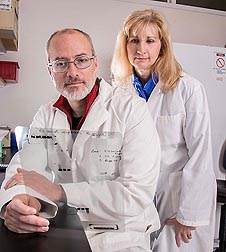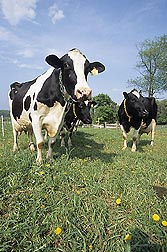New Discovery Makes Detecting Johne’s Disease Easier
|
|
Before a disease can be treated, it must first be identified. But that’s not always easy, especially in the case of Johne’s disease, which affects cattle, sheep, goats, deer, and other ruminants.
Johne’s disease—also known as “paratuberculosis”—is a costly, contagious disease that causes diarrhea, reduced feed intake, weight loss, and sometimes death. Annual estimated losses to cattle producers range from $40 to $227 per infected animal. For the U.S. dairy industry alone, losses exceed $220 million each year.
For years, scientists have been hampered by the fact that any antibody—a protein produced by the immune system to fight infections and foreign substances—used to detect the Johne’s disease bacterium also reacted to other environmental bacteria or maybe the pathogen responsible for bovine tuberculosis. This caused false-positive test results.
“You may think cattle are infected, based on a positive antibody test result, but they may simply have been exposed to nonpathogenic mycobacteria that’s ubiquitously present in the environment,” says microbiologist John Bannantine at the Agricultural Research Service’s National Animal Disease Center (NADC) in Ames, Iowa.
That problem, however, is now history. Bannantine and his colleagues at NADC have found an antibody that’s 100 percent specific in detecting Mycobacterium avium subspecies paratuberculosis (MAP)—the cause of Johne’s disease.
“No one else in the world has been able to find such a specific antibody that binds only to MAP strains, until now,” says Bannantine, who’s in NADC’s Infectious Bacterial Diseases Research Unit.
|
|
A Wild Goose Chase
After identifying the new antibody—called “17A12”—from mice immunized with MAP strain K-10, scientists decided to dig a little deeper to determine the protein this novel antibody binds to.
Initially, researchers believed they had found a new gene encoding the antibody-binding protein that was not originally identified in the MAP K-10 genome. They called it “UP1” (Unique Protein 1).
“In 2005, we sequenced the genome of a MAP cattle strain, and then annotated it—finding all the genes and identifying where they start and where they stop,” Bannantine says. “But the 17A12 antibody bound to a protein encoded by a gene that was not annotated in the MAPgenome. This was unusual, but we were excited about finding a potentially new gene.”
To confirm this unusual finding, Bannantine developed additional monoclonal antibodies to the UP1 protein. Only one of these new antibodies reacted with the native protein produced by MAP. It also happened to bind to the same area of the protein as the initial antibody—17A12.
“When we expressed the UP1 proteinin E. coli, it reacted with the monoclonal antibody, and we saw this as confirmation that UP1 was real, even though it wasn’t annotated in the genome,” Bannantine says.
Finding the Right Protein
But some of the data just didn’t add up. After additional experiments, it turned out that UP1 was not a real gene after all.
“It completely blew my mind. I had never had a day in the lab like that where there was such a revelation,” Bannantine says. “When we first got the results contradicting UP1 as a real gene, it was scary because we thought we had made some big mistakes. Then slowly all the pieces started to fit together, and we knew what we actually had. It was incredible.”
Although UP1 was not a gene, it had an epitope—a portion of a molecule to which an antibody binds. This epitope mimicked a similar epitope in the real gene.
In fact, Bannantine says, out of the seven amino acids that make up the epitope in UP1, one amino acid was different from the real epitope encoded by MAP1025, a gene that was annotated in the MAP genome.
With this new discovery, scientists not only found the real antibody-binding protein, but could now focus on the reason why the new antibody was so specific to MAP.
Solving the Mystery of Specificity
A sequence analysis showed that the MAP1025 gene was present in the non-MAP strains, which did not explain why the antibody was specific to M. paratuberculosis and not to environmental contaminants. To find the answer, Bannantine sequenced MAP1025 from several paratuberculosis and non-paratuberculosis strains.
He found a single nucleotide change in the sequence encoding the epitope. This change affected the first amino acid out of the seven that make up the epitope, which is what created the specificity of M. paratuberculosis, Bannantine says.
Researchers can now accurately detect the Johne’s disease pathogen and know for certain that it’s not a contaminant.
“We finally have a specific antibody to detect live mycobacteria in the tissues or feces of cattle. This could never have been done before,” Bannantine says.
Scientists have received a patent for the new antibody and are moving forward to develop diagnostic tests that will confirm the presence of the Johne’s disease bacterium.
“We can now use this antibody to enrich the bacterium when it is present in low concentrations, such as in unpasteurized milk samples,” Bannantine says. “Improved testing and diagnostics is really the big benefit of this antibody.”—By Sandra Avant, Agricultural Research Service Information Staff.
This research is part of Animal Health, an ARS national program (#103) described at www.nps.ars.usda.gov.
John Bannantine is in the USDA-ARS Infectious Bacterial Diseases Research Unit, National Animal Disease Center, 1920 Dayton Ave., Ames, IA 50010; (301) 337-7340.
Examining Johne’s Vaccines and Bovine TB Tests for Cross Reaction
Vaccines play a critical role in reducing the severity of Johne’s disease, but using them can become a balancing act if the vaccine cross-reacts with tests for other cattle diseases like bovine tuberculosis (TB)—an issue in states where wildlife are tracking TB back into dairy herds.
“Producers are concerned that if they vaccinate against Johne’s, they will not be able to discriminate whether their herd has bovine tuberculosis or Johne’s,” says microbiologist Judy Stabel, in the National Animal Disease Center’s Infectious Bacterial Disease Research Unit.
Stabel looked at the cross reactivity of an effective U.S. commercial vaccine with TB diagnostic tests. Several calves were vaccinated against Johne’s disease, and blood samples were taken over a period of 1 year. Immune and serological responses of calves were then measured using novel TB diagnostics that will be available in the future.
“These new serology tests for TB diagnostics are very promising,” Stabel says. “They’re similar to the stick pregnancy tests for humans, except you use serum.”
The tests consist of small sticks coated with bovine TB antigen. The antibody in the serum reacts to the antigen if it is positive.
With vaccinated calves, no reactivity was found using the TB tests, which is good because it means that those tests will not wrongly identify cattle with Johne’s disease as being positive for bovine TB, Stabel says.
“We also did skin testing, which is one of the main tests in the field for bovine tuberculosis, and found similar results,” she adds.
The results of these studies showed that calves could be vaccinated against Johne’s disease without interfering with bovine TB diagnostics.
A major advantage of the new serologic tests is the cost and ease of use, Stabel says. “Animals can be handled one time to obtain a blood sample rather than being handled twice to administer and read a skin test. That reduces veterinary costs.”—By Sandra Avant, Agricultural Research Service Information Staff.
Judy Stabel is in the USDA-ARS Infectious Bacterial Diseases Research Unit, National Animal Disease Center, 1920 Dayton Ave., Ames, IA 50010; (301) 337-7304.
"New Discovery Makes Detecting Johne’s Disease Easier" was published in the April 2013 issue of Agricultural Research magazine.








